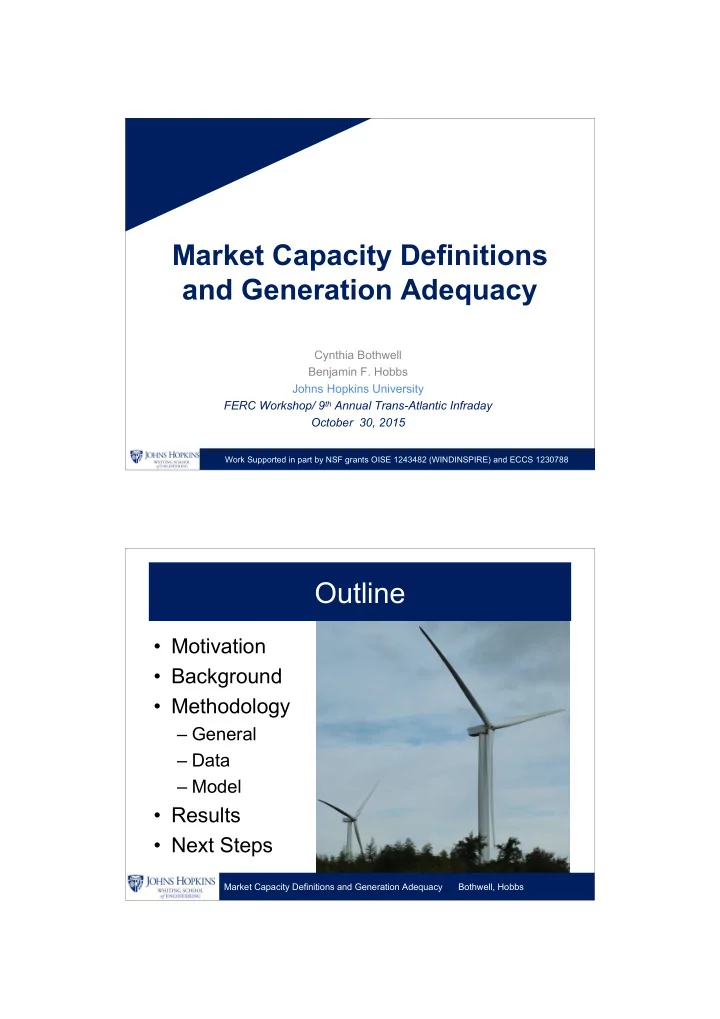

Market Capacity Definitions and Generation Adequacy Cynthia Bothwell Benjamin F. Hobbs Johns Hopkins University FERC Workshop/ 9 th Annual Trans-Atlantic Infraday October 30, 2015 Work Supported in part by NSF grants OISE 1243482 (WINDINSPIRE) and ECCS 1230788 Outline • Motivation • Background • Methodology – General – Data – Model • Results • Next Steps Market Capacity Definitions and Generation Adequacy Bothwell, Hobbs
Motivation • Earlier we examined how renewable technologies could impact capacity markets and allocation of market revenues among technologies Reliability constraint had large impact on portfolio mix, cost, and market distortions – study of RM and VOLL – Next week at Informs Given variable nature of renewable capacity, how do alternative definitions of capacity distort market outcomes? Additionally, how does an energy market price cap distort outcomes? Market Capacity Definitions and Generation Adequacy Bothwell, Hobbs Motivation 27.2% Wind Nameplate =(63520-60874)/9744 19.2% Wind Nameplate =(63520-61648)/9744 8.1% Wind Nameplate =(62437-61648)/9744 Load and Wind Data – Texas 2009 Market Capacity Definitions and Generation Adequacy Bothwell, Hobbs
Motivation Same Load Profile and Wind Pattern Wind Scaled from 10% to 40% Energy Peak Contribution shifted from 19.2% to 10.1% Of Wind Nameplate 10.1% Wind Nameplate =(63520-59574)/38975 Wind does not have a fixed % capacity contribution .. It depends on Year and Penetration Market Capacity Definitions and Generation Adequacy Bothwell, Hobbs Background Terminology • Reserve Margin (RM) – MW of (weighted, in general) generation capacity above the peak load requirement • Value of Lost Load (VOLL)– assumed $/MWh customers are willing to pay to avoid disruption of electric service • Expected Unserved Energy (EUE) – amount of MWh not served, considering potential component failures and insufficient reserve 6 Market Capacity Definitions and Generation Adequacy Bothwell, Hobbs
Methodology: General • Identify equilibrium electric generation capacity mix given different planning criteria: – minimum reserve margin with energy market subject to price cap, – VOLL, with no energy price cap – Vary the renewable capacity to reserves • Set reliability equal – determine cost • Static (single year) Market Capacity Definitions and Generation Adequacy Bothwell, Hobbs Methodology: Reserves • No current reserve convention with renewables • Traditionally, reserves are the amount of excess generation capacity over forecasted peak demand. • Three variations considered: 1. Excluding Renewables 2. Renewables as negative load 3. Renewables as generators: capacity contribution either predetermined or actual annual performance Market Capacity Definitions and Generation Adequacy Bothwell, Hobbs
Methodology: Data • ERCOT 2013 existing system using normalized hourly actual load, wind, and solar data • Load scaled to 50,000 MW Peak • New generation costs (EIA), except existing coal (lower “going forward” costs) Market Capacity Definitions and Generation Adequacy Bothwell, Hobbs Methodology: Model The Model Objective over 8760 hours: • Minimize TotalCost = InvestmentCost + VariableCost InvestmentCost = VariableCost = Market Capacity Definitions and Generation Adequacy Bothwell, Hobbs
Methodology: Model Subject to constraints: Reserve Margin Σ Gen Capacity >= Load * (1 + ReserveMargin ) for every hour Dispatch Dispatch <= Capacity for each generator, every hour LoadBalance Σ Gen Dispatch + Wind + Solar >= Demand – LostLoad every hour Coal Capacity Capacity(coal) <= PeakDemand * 0.45 Curtailments Curtailment <= Wind + Solar for every hour Availability Σ Hours Dispatch <= Capacity * AvailabilityFactor every generator Forced Outages Σ Gen Dispatch <= Σ Gen (Capacity * (1-EFOR)) for every hour RPS Σ Hours (Wind + Solar– Curtailment ) <= Σ Hours Demand * RPS Market Capacity Definitions and Generation Adequacy Bothwell, Hobbs Results: Varying VOLL Generation mix: • Energy dispatch similar even with lowest reserves. • Investment in capacity changed primarily with regard to gas turbines. • Value only changes how much excess you buy. Market Capacity Definitions and Generation Adequacy Bothwell, Hobbs
Results: VOLL vs EUE VOLL $10,000 VOLL $1,000 VOLL $10,000 Energy VOLL $1,000 Energy 13 Market Capacity Definitions and Generation Adequacy Bothwell, Hobbs Results: Renewable Capacity 1.56¢/MWh for renewable subsidies 63¢/MWh Mkt Cap $1,000 – Wind Cap 40%, Solar Cap 75% Mkt Cap $1,000 – Wind Cap 25%, Solar Cap 50% Mkt Cap $1,000 – Wind Cap 14.6%, Solar Cap 50% 19¢/MWh Mkt Cap $1,000 – Wind Cap 0%, Solar Cap 0% Optimal: VOLL $10,000, No Cap 14 Market Capacity Definitions and Generation Adequacy Bothwell, Hobbs
Next Steps •Current work: – Expand cases with more actual data – Add more operational characteristics – Examine magnitudes of market distortions •Analyze market equilibrium investment & operations under capacity designs • Assess the resulting distortions, efficiency, consumer impacts, and incentives for renewable investment 15 Market Capacity Definitions and Generation Adequacy Bothwell, Hobbs Results: Investment Mix Energy With Distortion Optimal Energy 16 Market Capacity Definitions and Generation Adequacy Bothwell, Hobbs
Acknowledgements Modeling: Calvin Wood, undergrad Virginia Commonwealth University Data Mining: Enyang “Ricky” Xia, Masters student Johns Hopkins University Reference: C.Bothwell & B. Hobbs, “ Electric Capacity Market Performance with Generation Investment and Renewables”, United States Association for Energy Economics,.33 rd USAEE/IAEE North American Conference, October 2015, Pittsburgh Market Capacity Definitions and Generation Adequacy Bothwell, Hobbs
Recommend
More recommend